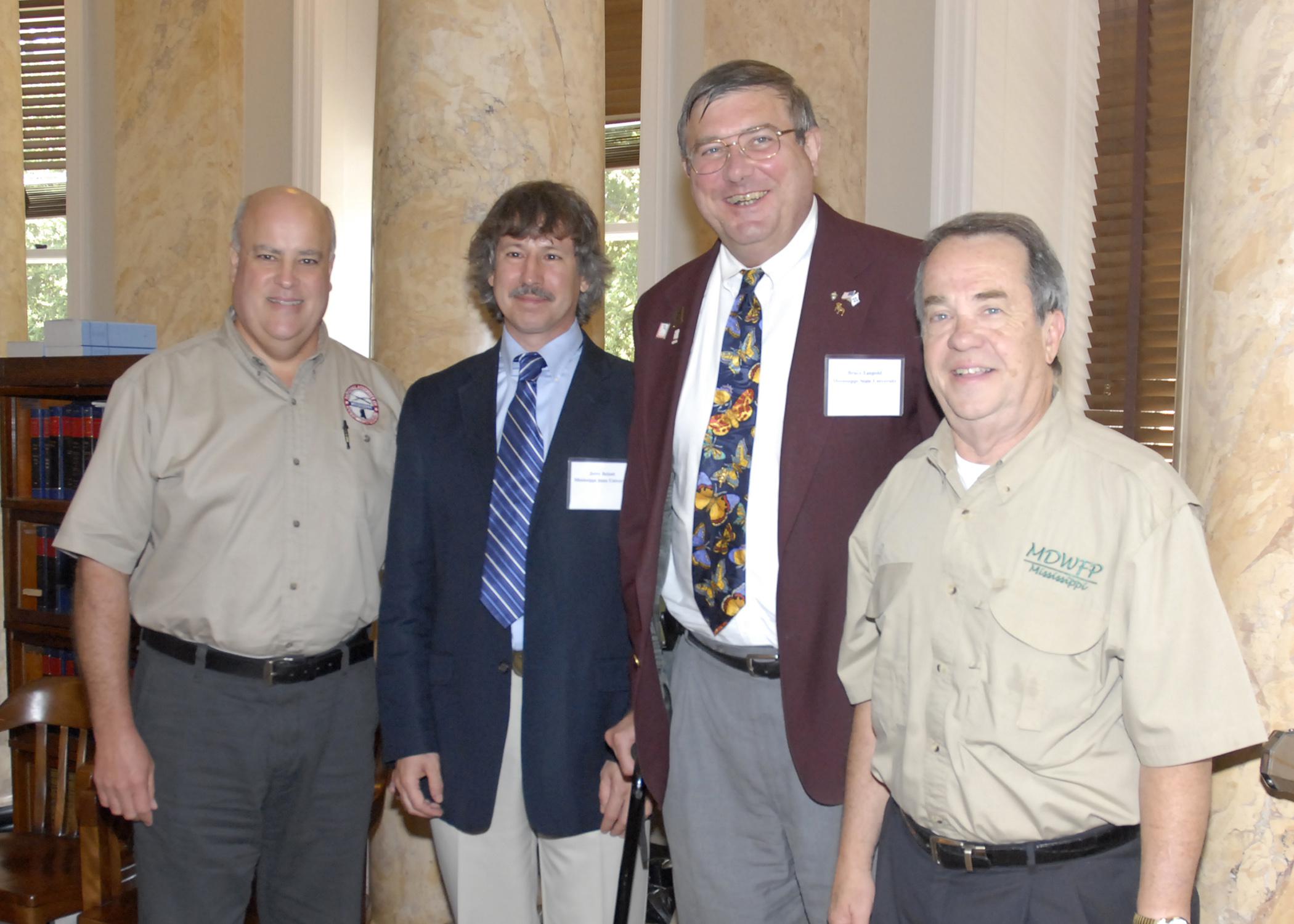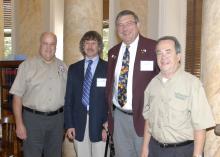Information Possibly Outdated
The information presented on this page was originally released on September 13, 2013. It may not be outdated, but please search our site for more current information. If you plan to quote or reference this information in a publication, please check with the Extension specialist or author before proceeding.
Mississippi legislators learn about wild hogs
JACKSON – Mississippi legislators attended a special meeting on Sept. 9 to learn about the “greatest emerging wildlife challenge of the 21st century.”
Bruce Leopold, executive director of the Mississippi State University Center for Resolving Human-Wildlife Conflicts, and other speakers offered that description of the nation’s rapidly expanding wild hog populations. Leopold, Rep. Scott Bounds and Sen. Giles Ward co-hosted an informational meeting of the state Senate and House wildlife, fisheries and parks committees to educate them on wild hog numbers in Mississippi and how other states have addressed similar problems.
“We wanted to bring key policy makers together and provide them with as much information about the problem as we could in a short meeting,” Leopold said. “Everyone needs to understand that you don’t have to be a landowner to be impacted negatively by wild hogs.”
Leopold said as the country becomes more urban and less rural, there will be greater opportunities for human and wildlife conflicts.
“Addressing the problems begins with educating people,” he said.
Organized by MSU’s Extension Service, Forest and Wildlife Research Center and the Mississippi Agricultural and Forestry Experiment Station, the legislative summit included comments from state and national experts on wild hog issues. They addressed hogs’ prolific reproductive ability, economic impact, and diverse and flexible diet. Discussions included disease concerns and population control options.
Texas A&M AgriLife Extension wildlife specialist Billy Higginbotham said Mississippi’s wild hog situation is similar to that found in Texas in 1985.
“I wish we had known then what Mississippi knows now,” he told summit participants. “Texas has between one-third and one-half of the wild pigs in the nation. We are at war with wild pigs in our state.”
A major factor contributing to the control problem is the wild hogs’ reproductive rate. Sows can produce an average of 1.5 litters per year, with five to six piglets each time. Allowing for some mortality, populations can double every five years.
“They are not born pregnant, but it’s awfully close,” Higginbotham said.
The economic impact of damage caused by wild hogs is significant. Pasture damage is the biggest problem, followed by destruction of row crops, orchards and landscapes.
“Conservatively, we have estimated a negative $50 million agricultural impact in Texas annually,” he said.
Higginbotham said there is minimal benefit to recreational wild hog hunting.
“Deer and wild pigs don’t mix. Deer will leave an area if wild pigs are present,” he said. “Hunters can grow old sitting on a deer stand waiting on a wild pig. You are not going to control them with recreational hunting methods.”
Higginbotham said 57 percent of the wild hogs harvested in Texas are removed by trapping. Legislation referred to as the “Porkchopper Bill” allows hunters to shoot wild hogs from helicopters. Texas has an open season and no limit, but the wild hog population is still expanding at about 20 percent annually.
“The last thing we want is for landowners to give up,” he said. “Early detection of wild hog presence is a critical step in abatement of damage.”
Jack Mayer of the Savannah River National Laboratory in South Carolina and author of “Wild Pigs in the United States” encouraged legislators to set goals to address problems with wild hogs.
“Eradication is not in the cards for Mississippi, but efforts can be made to stop the expansion of populations,” he said. “You need to coordinate with surrounding states; otherwise, populations will just cross state lines as they feel pressure from other areas.”
Similar coordinated efforts need to be made between neighboring landowners in the state. Fencing or hunting pressure will mainly push populations away for just a short time.
Mayer said some legislative issues Mississippi must resolve include decisions on what agencies are responsible. Mississippi officials need to decide whether wild hogs are an agricultural or a wildlife issue and whether they are nuisance animals or invasive species. He encouraged legislation that will prevent transportation of live wild hogs for sport or other purposes.
“Sport hunting of these animals is what led to the ‘pig bomb’ or population explosion we are seeing,” he said.
Mayer said scientists have found genetic links to wild hogs from many states away, which is an indication that humans helped them invade other regions.
For those who see hunting wild hogs as a fun sport idea, Mayer warned them to think again.
“This is not a joke. We never saw this (problem) coming,” he said.
Dr. Fred Cunningham, a veterinarian with the National Wildlife Research Center in the U.S. Department of Agriculture’s Wildlife Services, said wild hogs can carry more than 30 diseases that can infect humans, pets, livestock and wildlife. These diseases include pseudorabies, brucellosis, salmonella, influenza, erysipelas, E. coli, bovine tuberculosis, anthrax and potentially even a foreign animal disease like foot-and-mouth.
Lawmakers will convene in January to further discuss potential legislation to help farmers and landowners.





